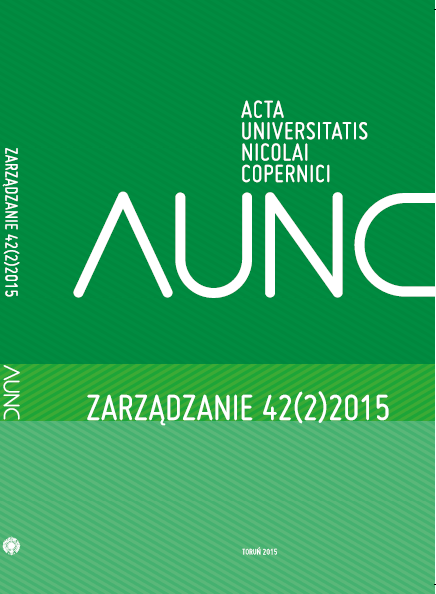PROCEDURY I NARZĘDZIA INFORMATYCZNE SŁUŻĄCE DO OCHRONY WŁASNOŚCI INTELEKTUALNEJ ORGANIZACJI OPARTEJ NA WIEDZY
DOI:
https://doi.org/10.12775/AUNC_ZARZ.2015.024Słowa kluczowe
ochrona własności intelektualnej, kapitał intelektualny, systemy informatyczneAbstrakt
Artykuł omawia problematykę zarządzania wiedzą, w tym w szczególności wiedzą chronioną. Podejmuje problematykę metod ochrony własności intelektualnej oraz sposobu wyceny kosztów spowodowanych naruszeniami organizacyjnych zasobów własności intelektualnej. Artykuł przedstawia kategorie systemów informatycznych i stosowanych w nich mechanizmów ochrony kapitału intelektualnego, które zajmują się prawidłowym obiegiem informacyjnym, monitorowaniem informacji wchodzącej i wychodzącej z organizacji, a także skutecznym zabezpieczaniem informacji w formie elektronicznej. W artykule przedstawiono cechy system służący ochronie własności intelektualnej przechowywanej w publicznie dostępnych dokumentach tekstowych.Bibliografia
Aberdeen Group Report (2007), "Thwarting Data Loss. Best in Class Strategies for Protecting Sensitive Data", Aberdeen Group Press.
Brotby W. K. (2009), Information security management metrics : a definitive guide to effective security monitoring and measurement, Boca Raton, Auerbach Publications.
Cavusoglu H. , Mishra B., Raghunathan S. (2004), A model for evaluating it security investments, Communication of ACM, 47(7), ACM.
Ceglarek D. (2013), Linearithmic Corpus to Corpus Comparison by Sentence Hashing Algorithm SHAPD2, [w]: The 5th International Conference on Advanced Cognitive Technologies and Applications, Curran Associates, Valencia (Spain).
Edvinsson L., Malone M. S. (2001), Kapitał intelektualny, PWN, Warszawa.
Forrester Research Report (2010), "The Value Of Corporate Secrets. How Compliance And Collaboration Affect Enterprise Perceptions Of Risk", Forrester Research Inc., Cambridge.
Haley K. (2011), 2011 Internet Security Threat Report Identifies Increased Risks for SMBs, Symantec Report.
ISF. The standard of good practice for information security (2005). Technical report, Information Security Forum.
Jaquith A., Balaouras S., Crumb A. (2010), The Forrester Wave™: Data Leak Prevention Suites, Q4 2010.
Meyer R., de Witt B. (1998), Strategy-Process, Content, Context, International Thompson Business Press, London.
Petrao B. (2011), Managing the risk of information leakage, Continuity Central.
Poore R. S. (2000), Valuing information assets for security risk management., Information Systems Security.
Probst G., Raub S., Romhard K. (1999), Wissen Managen. Wie Unternehmen Ihre Wertvolle Ressource Optimal Nutzen, Gabler, Frankfurt.
Pulic A. (2004), Intellectual Capital – Does it Create or Destroy Value?, „Measuring Business Excellence”, Vol. 8 (1).
Ricceri F. (2008), Intellectual Capital and Knowledge Management. Strategic management of knowledge resources, Routledge Francis & Taylor Group, New York.
Sroka H. (2007), Zarys koncepcji nowej teorii organizacji zarządzania dla przedsiębiorstwa e-gospodarki, Wydawnictwo Akademii Ekonomicznej w Katowicach, Katowice.
Stewart T.A.(1995), Trying to Grasp the Intangible, „Fortune”, Vol. 132 (7), s. 158.
Pobrania
Opublikowane
Jak cytować
Numer
Dział
Statystyki
Liczba wyświetleń i pobrań: 2094
Liczba cytowań: 0







